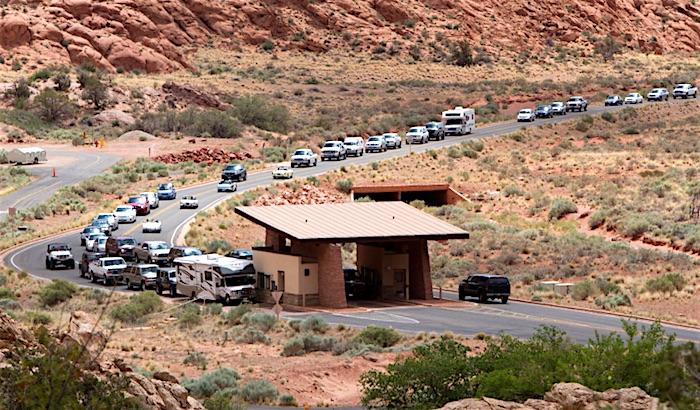
An economic analysis will be prepared on a traffic management plan proposed for Arches National Park/NPS
Concerns over how a traffic management plan at Arches National Park in Utah could affect the regional economy has prompted the National Park Service to hire an outside consultant to examine that question.
While some national parks are grappling with human crowds, at Arches in southeastern Utah the problem is vehicular crowds. With a very limited road system, built around the 18-mile-long main road, traffic can quickly slow to a crawl during the spring, summer, and fall seasons at the park's main attractions, such as Delicate Arch, the Windows Section, and Devils Garden.
To unwind that congestion, Arches staff has been developing a Traffic Congestion Management Plan to address vehicle traffic and parking congestion problems that they say affect visitor access, visitor enjoyment, and resource conditions.
The plan under consideration proposes a reservation system for entrance during high-visitation season and peak-visitation hours. This system would give visitors certainty of entry, reduce or eliminate long entrance lines, spread visitation more evenly across the day, and improve the visitor experience by ensuring available parking space, a park release said.
Reservations would be required for vehicle entry between 7 a.m. and 6 p.m., seven days a week during high-visitation season (currently March through October, but this may shift as visitation patterns change), and could be made online or by phone through www.recreation.gov.
But the plan has raised concerns and drawn opposition, including from Utah Gov. Gary Herbert. In a letter (attached below) to Arches Superintendent Kate Cannon sent in December, the governor voiced doubts that "all feasible solutions have been explored," adding that "the plan lacks sufficient detail in critical areas."
"Among these critical areas is a concern that the plan may create unintended negative consequences in the community of Moab and on surrounding public lands," wrote Gov. Herbert.
During the public comment period on the plan, from November 1 to December 18 last year, 421 comments were received by the park.
"The NPS received a number of substantive comments questioning the analysis of impacts on the local economy. In response to these comments, NPS has engaged an outside expert to evaluate potential economic impacts associated with the proposed reservation system," a park release sent Friday said. "The evaluation will be conducted by Chip Paterson, a principal with Industrial Economics, Inc. (IEc). IEc is an economics and public policy consulting firm based in Cambridge, Massachusetts. Paterson's work focuses on the economics of natural resource management, including changes in the quality and availability of recreational opportunities. IEc’s evaluation will be based on existing information."
A final report from Mr. Paterson is expected this summer.



Comments
A key to making this hing work is going to be a flexible and functional recreation.gov system. Not sure we have that right now?
You would think this type of analysis would have already been done prior to the aternative being floated.
OK, but lets make sure the analysis includes the environmental impacts balanced against the economics. It is not just about the money.